58 years of what has become known as the Tibetan Cause seems to be coming to an end. While the Tibetan community has long been privy to the Dalai Lama’s wish for Tibetan autonomy under Chinese rule, external observers beginning with The Economic Times (23rd November 2017) are now witnessing what they see as the Dalai Lama’s reversal in his stance and attitude towards China.
No longer is China couched as the Tibetan people’s Enemy No. 1 that has to be opposed vehemently. Instead on November 23 this year, in speaking to The Hindustani Times, the Dalai Lama stated that China and Tibet have always been close although there were ‘occasional fights’.
China now is presented in the Dalai Lama’s new narrative as a partner who can bring ‘more development’ and progress into Tibetan lives, as opposed to the hostile destroyer of the Tibetan people’s culture, religion and way of life. In addressing the Sino-Tibetan conflict that began in 1950 and culminated in the Dalai Lama’s escape into exile in 1959, the Dalai Lama was heard saying,
The past is the past.
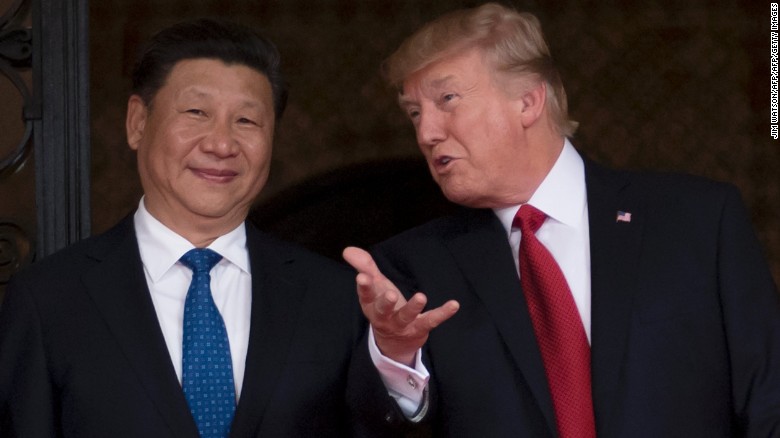
US President Donald Trump (right) with President Xi Jinping of China. Like most world leaders today, President Trump has shown no interest in maintaining a relationship with the Tibetan leadership, snubbing meetings with the Dalai Lama in favor of drawing a closer relationship with China.
After over half a century of rousing Tibetan and global support against China, the Dalai Lama’s turnaround is not without some serious implications and repercussions.
- The most immediate intimation is that 151 Tibetans who self-immolated for a ‘free Tibet’ literally wasted their lives. Those who self-immolated did not set themselves alight so that ultimately, the Dalai Lama would accede to China’s sovereignty and acknowledge China as an ally who can bring progress to the Tibetan people.
Not only does the Dalai Lama’s renewed push for autonomy invalidate these self-immolations, but the Tibetan leadership’s silence on these self-immolations, knowing how their intent does not match the Dalai Lama’s wishes, is shocking. The Dalai Lama and Central Tibetan Administration (CTA; Tibetan leadership in Dharamsala) must now take a stance against all future self-immolations and outlaw the act as unpatriotic because it now goes against the foreign policy goals of the Tibetan government.
- The Dalai Lama and CTA should henceforth cease all anti-China rhetoric and should in no way participate in anything that is subversive to China’s stature and reputation. Instead, the Dalai Lama and CTA should openly acknowledge that China has brought progress to the Tibetan people within the Tibet Autonomous Region (TAR), and they can do the same for the Tibetans in exile, pending a positive relationship that is contingent on the CTA’s willingness.
In essence, this would mean the CTA should divest of all its interest and involvement in operations like Radio Free Asia, which is described in Wikipedia as “…a private, non-profit international broadcasting corporation that broadcasts and publishes online news, information, and commentary to listeners in East Asia while ‘advancing the goals of U.S. foreign policy.’” Surely in geopolitical terms, advancing the goals of U.S. foreign policy is at the expense of China’s foreign policy as both superpowers are vying for dominance in the same global market.
Therefore if the Dalai Lama and CTA are sincere about being autonomous under China, as the Tibetan spiritual leader has proclaimed, it behooves them to stop being a shill for American foreign policy and show that they have China’s interests at heart. It would also mean that the CTA must henceforth stop receiving grants and any form of funding from countries that are critical of China, for instance the United States.
- As a show of its good intentions, the Dalai Lama and CTA must immediately call for a cessation of all CTA policies that have split the Tibetan communityboth within Tibet and in the diaspora. The most critical of these would be:
- The Rangzen vs. Umaylam Split: The CTA must now make all efforts to reconcile the two groups instead of demonizing Rangzen advocates as being an ‘internal enemy’ as Sikyong Lobsang Sangay has recently claimed, and as ex-CTA Prime Minister Samdhong Rinpoche has announced previously.
- The Karma Kagyu Split: The Dalai Lama should now use his influence to close ranks in the Karma Kagyu lineage. It became divided after the Dalai Lama acted beyond his mandate in the Karma Kagyu’s succession issue and endorsed a rival Karmapa to the one that the lineage chose per their centuries-old tradition.
- The Dorje Shugden Issue: The Dalai Lama and CTA must immediately cease all victimization and persecution of Dorje Shugden practitioners by labelling them traitors of the Tibetan people. This conflict that the Tibetan leadership started and sustained for the past 20 years has injuriously divided the Tibetan people and Tibetan Buddhist adherents worldwide.
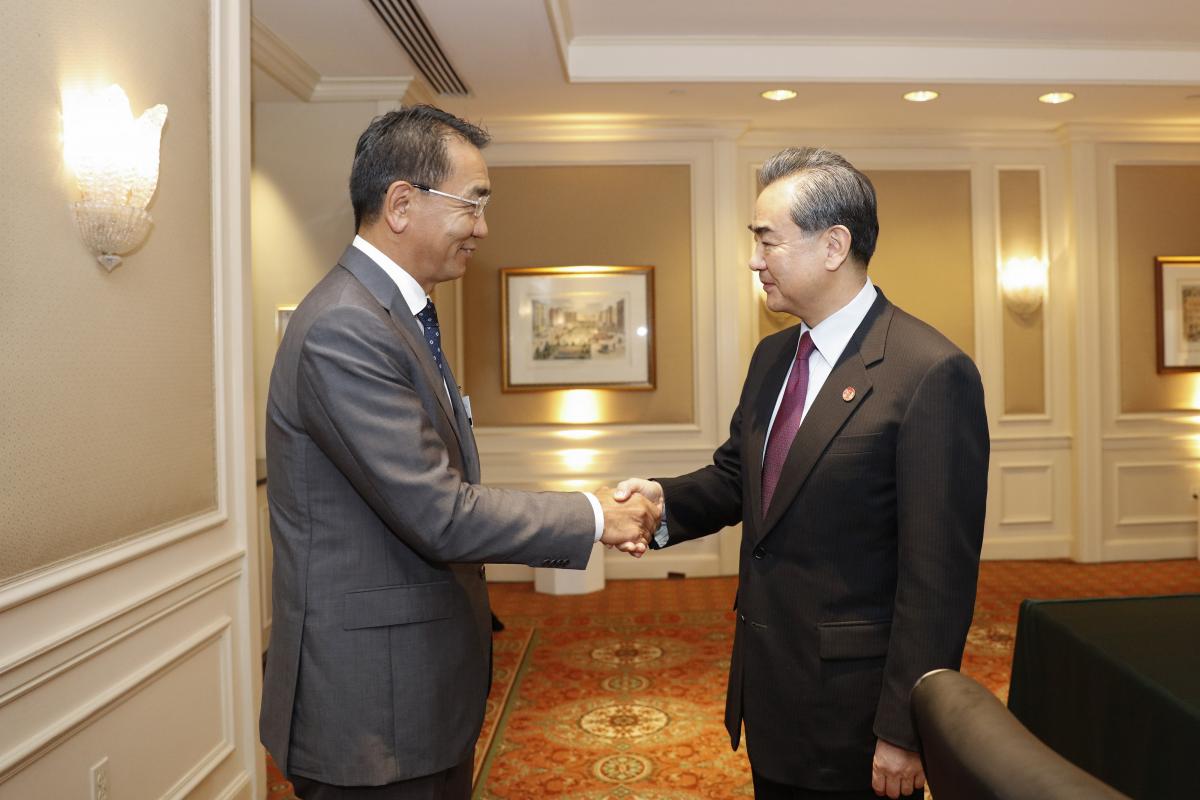
Mongolian Foreign Minister Tsend Munkh-Orgil on the left. The Dalai Lama is now banned from Mongolia, after China voiced their objections to his visit. A traditionally strong supporter of Tibet, Mongolia is just one of many countries around the world who are increasingly unwilling to risk their citizens’ economic welfare for a relationship with the Tibetan leadership which brings no benefits to their population at large.
An announcement by the Dalai Lama ordering all such persecutions to stop would no doubt put an end to the infighting amongst Tibetans inside Tibet. They have been enthusiastic to violently enforce the Tibetan leadership’s diktats against Shugden practitioners, and the ensuing instability and conflict is something that has been of grave concern to the Chinese government.
In addition, the CTA must remove all anti-Dorje Shugden propaganda material on their official website and on the Dalai Lama’s page, which, as long as they are there, absolves the Tibetan people of all liabilities in persecuting their own kin based on their religion.
In the event the Tibetan leadership fails to do this, then they will be leaving it to the Chinese government to put out a fire that the CTA started and kept going.
You Lose When You Support the Tibetan Leadership
But the Dalai Lama’s change of attitude towards China also bears some serious overtones in the Sino-Indian relationship, which should worry India. After supporting, at great cost, the majority of the Tibetan exodus for almost 60 years, the Tibetan leadership might now hang their generous Indian hosts out to dry.
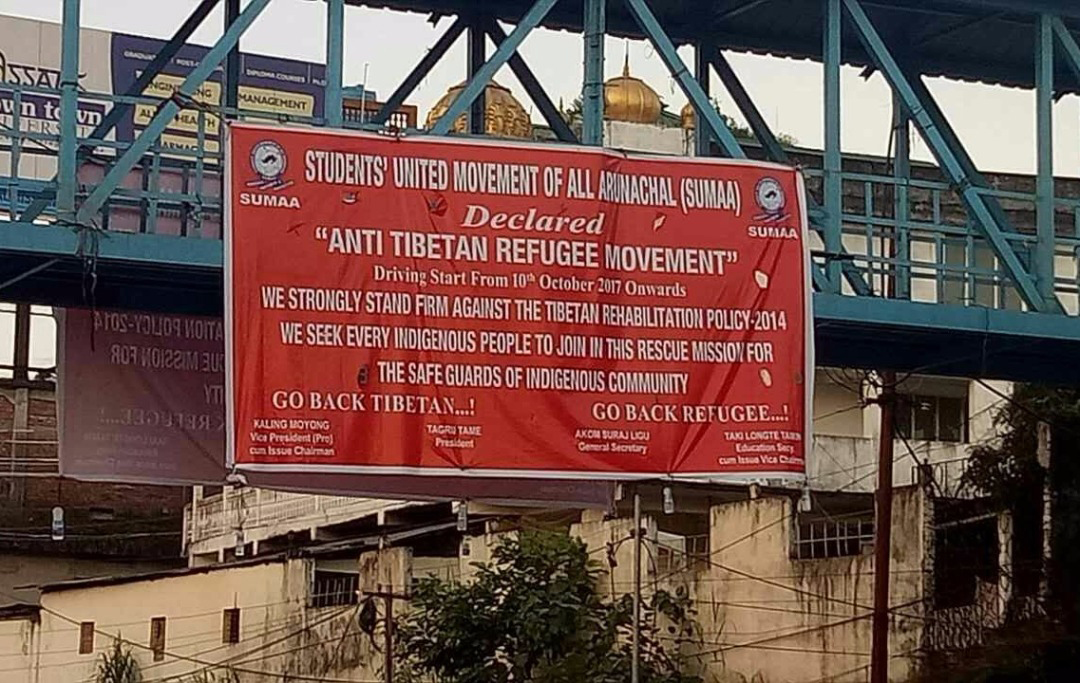
Anti-Tibetan sentiment, especially in India, is increasingly obvious. Earlier this year, students in the Indian state of Arunachal Pradesh launched an anti-Tibetan protest, highlighting the preferential treatment of Tibetan refugees over Indian citizens, and calling for the removal of Tibetan refugees from India.
Sino-Indian relationships have never been tenser. Over the decades, these two Asian giants have clashed at one time or another over Arunachal Pradesh, Jammu and Kashmir, Ladakh and most recently, Doklam. India and China’s border issues remain largely unresolved and incendiary. With such sensitive issues at stake, will the Dalai Lama avail himself to stand against India in exchange for favorable terms, as he has against China for decades? The Dalai Lama remains an extremely influential and potent force on his own and we have seen how he managed to turn the world’s attention against China for decades.
Not only did India lose out by supporting the Tibetan cause, but it now stands to lose if the Tibetan leadership turns around and supports China in any Sino-Indian disputes. And there is every possibility that this might happen. On 4th December 2017, The Wire published an article by Phunchok Stobdan, a former Indian ambassador who was commenting on the Tibetan situation. The article included a very interesting revelation – that Samdhong Rinpoche, the newly-appointed Special Representative of the Dalai Lama has been on a discreet visit to China since mid-November.
Samdhong Rinpoche is said to be visiting a part of China (Yunnan) where he has a big following. The choice of location has been viewed as a strategic move by many, as it affords the CTA a margin of deniability or ability to classify the trip as a private visit in case nothing should come of it later. Nevertheless, the previously-unreported news has sent shockwaves throughout the Tibetan community, who view it as a sign that the Dalai Lama and Tibetan leadership may be ready to relinquish a strong relationship with India, in favor of talks with China.
The fact that the Tibetan leadership may just renege on their relationship with India has not gone unnoticed by the community at large. In the comments section of The Wire article, a remark left by an ‘Alok Asthana’ sums up the situation perfectly by saying,
Providing sanctuary to Dalai Lama and angering China has been India’s monumental blunder. Think back of the last of the 40s. What if India had snubbed this man and made friends with China. The state of India would have been quite different today. Maybe Dalai Lama’s exit provides us with that opportunity again. Make friends with China.
Is This Another Tibetan Leadership Ruse?
Nothing the Tibetan leadership does is ever straightforward. The CTA declares itself to be a democracy and yet publishes propaganda material to deny religious freedom to a large segment of its exile population. The CTA claims not to be pushing for independence with China (Rangzen) and yet does nothing to curb Rangzen activities including self-immolations.
And now, true to form, even as the Dalai Lama seems to be extending an olive branch to China, Sikyong Lobsang Sangay is on a European tour to muster support for another 50 years of opposing China. What indeed are the Tibetan leadership’s true intentions?
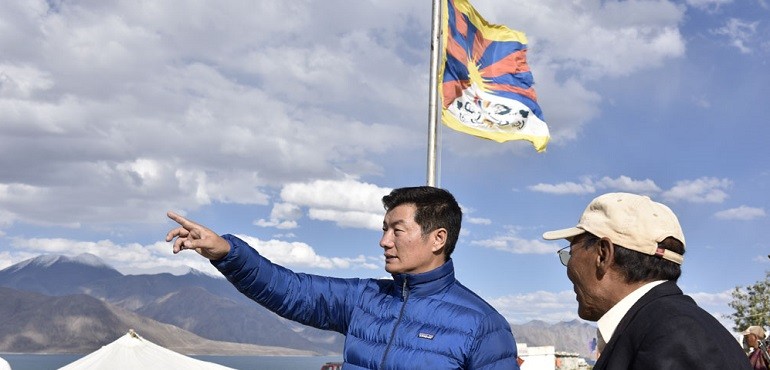
Sikyong Dr Lobsang Sangay of the Central Tibetan Administration. In a stunning display of insensitivity for Sino-Indian politics, the Tibetan leader caused a furore when he was pictured raising the Tibetan flag at Pangong Lake, between Ladakh and Tibet. This incident took place at the height of the Doklam crisis which, at that point, was on the brink of escalating into war between China and India. The Chinese leadership viewed the Prime Minister’s actions as intentionally provocative, and they responded with strong statements of objections to the Indian leaders. There is no doubt what Lobsang Sangay did contributed to the degeneration of relations between China and India.
The reality is all this posturing by Dr Lobsang Sangay will ultimately be futile and counterproductive. The Tibetan leadership has clearly miscalculated its own significance again and is in complete denial of the fact that more and more doors are now closed to it. Over the last few years, we have seen Sweden, Switzerland, Nepal, Australia, Bhutan, Pakistan and even old friends like Mongolia rejecting the Dalai Lama. The U.S. under President Trump is clear that it prefers to make friends with China than continue to support the exile Tibetan leadership’s struggle against China. And of late, we see growing resentment of the Tibetan people in India itself. The Tibetan leadership in all its scheming and conniving is alone.
And so one has to ask, on what basis is the Tibetan leadership planning to oppose a China that is only growing stronger by the day, especially when the CTA cannot even get its own act together? Truly, it is curtains for the CTA and the Tibetan cause.
The Dalai Lama Wants to Return Home
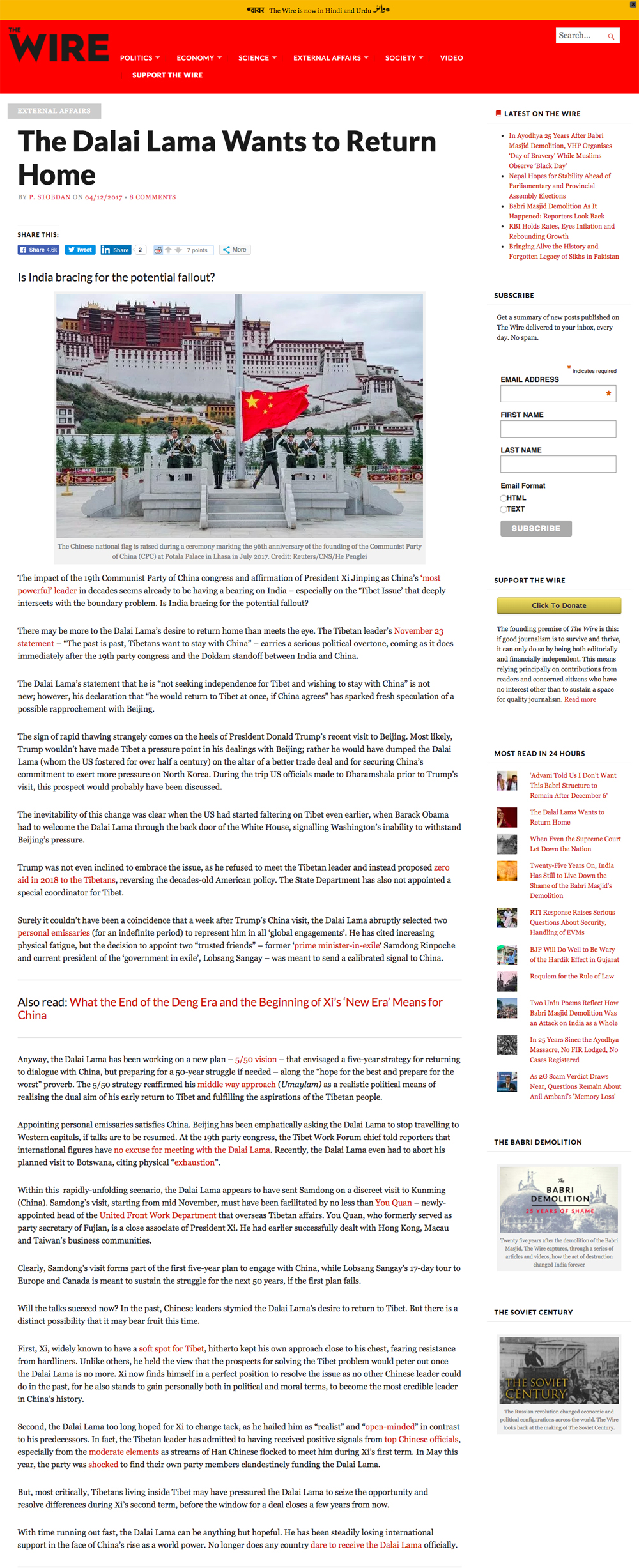
Click to enlarge (Source: https://thewire.in/201726/dalai-lama-india-china-tibet/)

Click to enlarge and read the comments to The Wire article (Source: https://thewire.in/201726/dalai-lama-india-china-tibet/)
Dalai Lama’s Envoy Samdhong Rinpoche Discreetly Visited China

Click to enlarge (Source: http://www.tibetanjournal.com/index.php/2017/12/05/dalai-lamas-envoy-samdhong-rinpoche-visited-china/)
MORE NEWS LIKE THIS